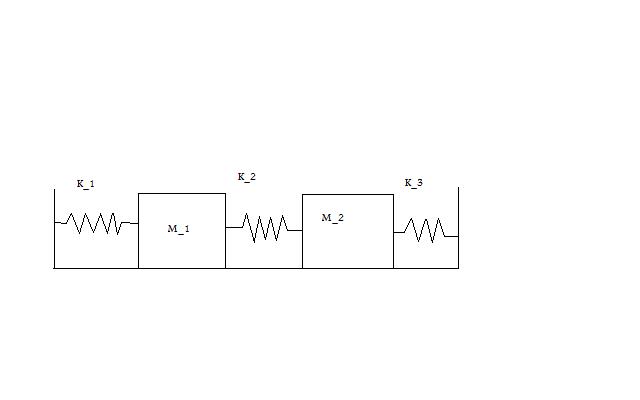Coupled Oscillator: horizontal Mass-Spring: Difference between revisions
Jump to navigation
Jump to search
| Line 112: | Line 112: | ||
</math> |
</math> |
||
== Eigen Values == |
|||
Once you have your equations of equilibrium in matrix form you can plug them into a calculator or a computer program that will give you the eigen values automatically. This saves you a lot of hand work. Here's what you should come up with for this particular problem given these initial conditions. |
|||
:'''Given''' |
|||
:<math>m_1=10kg\,</math> |
|||
:<math>m_2=5kg\,</math> |
|||
:<math>k_1=25\,{N\over {m}}</math> |
|||
:<math>k_2=20\,{N\over {m}}</math> |
|||
We now have |
|||
:<math>\begin{bmatrix} |
|||
\dot{x_1} \\ |
|||
\ddot{x_1} \\ |
|||
\dot{x_2} \\ |
|||
\ddot{x_2} |
|||
\end{bmatrix} |
|||
= |
|||
\begin{bmatrix} |
|||
0 & 1 & 0 & 0 \\ |
|||
-4.5 & 0 & 2 & 0 \\ |
|||
0 & 0 & 0 & 1 \\ |
|||
4 & 0 & -4 & 0 |
|||
\end{bmatrix} |
|||
\begin{bmatrix} |
|||
{x_1} \\ |
|||
\dot{x_1} \\ |
|||
{x_2} \\ |
|||
\dot{x_2} |
|||
\end{bmatrix} |
|||
+ |
|||
\begin{bmatrix} |
|||
0 \\ |
|||
0 \\ |
|||
0 \\ |
|||
0 |
|||
\end{bmatrix}</math> |
|||
From this we get |
|||
:<math>\lambda_1=2.6626i\,</math> |
|||
:<math>\lambda_2=-2.6626i\,</math> |
|||
:<math>\lambda_3=1.18766i\,</math> |
|||
:<math>\lambda_4=-1.18766i\,</math> |
|||
Revision as of 13:52, 10 December 2009
Problem Statement
Write up on the Wiki a solution of a coupled oscillator problem like the coupled pendulum. Use State Space methods. Describe the eigenmodes and eigenvectors of the system.
Initial Conditions:
Equations for M_1
Equations for M_2
Additional Equations
State Equations
=
With the numbers...
=
Eigen Values
Once you have your equations of equilibrium in matrix form you can plug them into a calculator or a computer program that will give you the eigen values automatically. This saves you a lot of hand work. Here's what you should come up with for this particular problem given these initial conditions.
- Given
We now have
From this we get




















